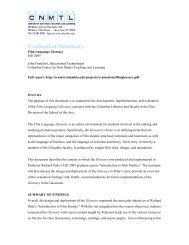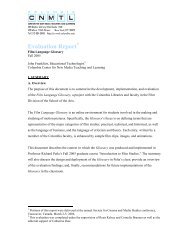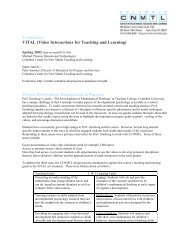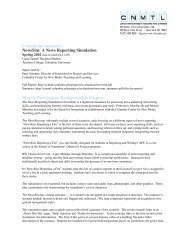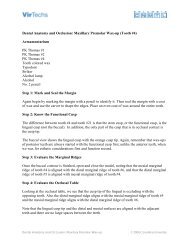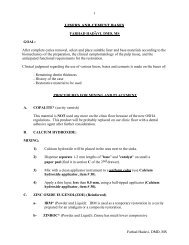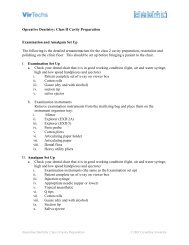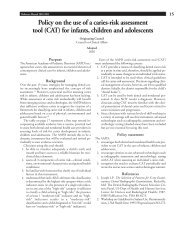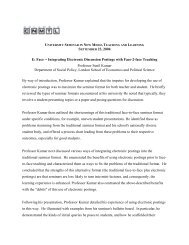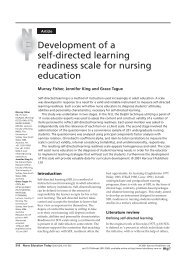University Seminar: Dr. Charles Kinzer - Columbia Center for New ...
University Seminar: Dr. Charles Kinzer - Columbia Center for New ...
University Seminar: Dr. Charles Kinzer - Columbia Center for New ...
You also want an ePaper? Increase the reach of your titles
YUMPU automatically turns print PDFs into web optimized ePapers that Google loves.
<strong>University</strong> <strong>Seminar</strong> on <strong>New</strong> Media Teaching and Learning<br />
3/3/05 Meeting<br />
Considerations of Design, Pedagogy and Evaluation of Electronic Case-Based Learning<br />
Environments<br />
<strong>Dr</strong>. <strong>Charles</strong> <strong>Kinzer</strong><br />
Professor of Education<br />
Department of Mathematics, Science and Technology<br />
Teachers College<br />
Summary by Linda Catalano, Rapporteur<br />
<strong>Charles</strong> <strong>Kinzer</strong>, Professor of Education in the Department of Mathematics, Science and<br />
Technology at Teachers College, <strong>Columbia</strong> <strong>University</strong>, began his presentation on Case<br />
Technologies to Enhance Literacy Learning (CTELL) project by stating that "retrofitting" theory to<br />
design is problematic. Instead, he continued, one should specify theories up-front, and then<br />
consider design. This helps one to remain clear about why selected actions were taken and to<br />
develop assessment tools based on theories.<br />
CTELL reflects an "anchored instruction" approach to the teaching of effective literacy instruction.<br />
<strong>Kinzer</strong> identified three issues in anchored instruction that CTELL is designed to address. These<br />
are: dissimilar student backgrounds, differences in shared knowledge, and "inert knowledge," or<br />
"things you know <strong>for</strong> a test and then don't use." With respect to the latter, <strong>Kinzer</strong> referred to the<br />
theory of cognitive flexibility, which maintains that situated learning facilitates the transfer of<br />
knowledge to real-world problems, in the process, he added, creating background knowledge and<br />
also shared knowledge.<br />
In constructing environments like CTELL, <strong>Kinzer</strong> specified that the concern should be with the<br />
construction and content of cases, and then with the interface design. In selecting the cases that<br />
populate CTELL, <strong>Kinzer</strong> reported that the project team tried to represent diverse conditions, such<br />
as those in Tennessee versus Chicago, <strong>for</strong> example.<br />
<strong>Kinzer</strong> noted that "cases" in education are different from "cases" in law or medicine. He explained<br />
that whereas in law, cases are based on precedent, and in medicine on diagnosis, in education<br />
they are based on a social system. Cases in education there<strong>for</strong>e need to be structured differently<br />
from other types of cases.<br />
<strong>Kinzer</strong> also stressed the idea that the case is not an example. He recommended providing cases<br />
that have key elements in common will enable students to analyze a prototype across classrooms.<br />
Page 1
<strong>University</strong> <strong>Seminar</strong> on <strong>New</strong> Media Teaching and Learning<br />
3/3/05 Meeting<br />
In CTELL, video is combined with other media (e.g., text) to <strong>for</strong>m cases of effective literacy<br />
instruction. <strong>Kinzer</strong> clarified that in CTELL, the case is the classroom, including teacher, students,<br />
and others who impact the reading curriculum. The anchor consists of a one-minute teacher<br />
voice-over followed by a 20-minute video segment of effective reading instruction. <strong>Kinzer</strong> noted<br />
that students must view the anchor video be<strong>for</strong>e accessing the other components of the case. He<br />
explained that this means that everyone starts at the same place, thus resolving the instructional<br />
issue of divergent background knowledge.<br />
In describing the web interface developed <strong>for</strong> CTELL, <strong>Kinzer</strong> paid particular attention to its initial<br />
page. He pointed out that it displays the full range of cases available <strong>for</strong> review, thus enabling<br />
students to choose to explore them in<strong>for</strong>mally.<br />
<strong>Kinzer</strong> further explained that one should think of the interface design as a shell because the aim is<br />
to learn and assess principles of effective literacy instruction in an environment. He added that<br />
the videos could be utilizing various kinds of environments and subjects — whether they are auto<br />
mechanics or a third grade classroom is irrelevant. The focus is not on the content of the lesson<br />
but rather on how it is delivered.<br />
After viewing the anchor, users are free to access the remaining components of the case. These<br />
fall into three categories: children, class, and interviews. The "Children" category features<br />
in<strong>for</strong>mation about three students from each classroom, including test scores, video of them<br />
reading aloud, samples of their written work, and interviews both with them and their parents.<br />
The "Class" category contains a diagram of the classroom, additional student work, teacher lesson<br />
plans, assignments, and additional video of appropriate literacy instruction. The "Interviews"<br />
section contains commentary by the target teachers, teachers in the grades above and below,<br />
school principals, and assorted literacy experts. <strong>Kinzer</strong> noted that interview subjects were all<br />
asked the same questions so students could compare the responses.<br />
Users can access multiple aspects of the same case and/or individual aspects of multiple cases.<br />
This allows them to draw comparisons within, between and across cases. For example, they can<br />
listen to various children reading the same passage of text and analyze differences in skill.<br />
A key feature of CTELL is the ability of the learner to excerpt and bookmark any of the case<br />
components within it — segments of video or of children's work, <strong>for</strong> example. This allows students<br />
to identify and review significant aspects of the case. Other notable features of the site include the<br />
ability to print samples of children's work; to record and save notes on the case; and to email<br />
Page 2
<strong>University</strong> <strong>Seminar</strong> on <strong>New</strong> Media Teaching and Learning<br />
3/3/05 Meeting<br />
these segmented elements to other members of the class <strong>for</strong> comment. <strong>Kinzer</strong> pointed out that<br />
the latter capability fosters group analysis and reflection, a central tenet of case-based<br />
instruction.<br />
Another prominent feature of CTELL that <strong>Kinzer</strong> described is the "Portfolio," a section of the site<br />
that is divided into areas corresponding to twelve instructional principles of effective literacy<br />
instruction. Students are directed to bookmark case components under the various headings.<br />
Thus students can mix and match cases and their respective elements. Moreover, the portfolio is<br />
viewable by the instructor (at either his/her own or the student's initiative), enabling faculty to<br />
assess the students' understanding of the relevant principles.<br />
The second part of <strong>Kinzer</strong>'s presentation detailed ef<strong>for</strong>ts to evaluate the CTELL environment.<br />
Specifically, <strong>Kinzer</strong> explained, the team has been interested to know whether participating<br />
students display any change in their knowledge of effective literacy instruction. The team has<br />
sought to detect and measure such change primarily through concept maps. These were analyzed<br />
<strong>for</strong> their internal links and more specifically, <strong>for</strong> the number, centrality and specificity of their<br />
constituent nodes. These scores were used to gauge students' understanding of the elements of<br />
and relationships among "effective literacy instruction."<br />
<strong>Kinzer</strong> explained that because conceptual change is difficult to measure, the team paired the<br />
concept map task with pre- and post- interviews. These focused on how students addressed<br />
different principles of effective literacy instruction in the classroom. <strong>Kinzer</strong> reported that the team<br />
plans to incorporate an assessment of student narratives into their evaluation rubric. This might,<br />
<strong>for</strong> example, involve students picking a set of nodes and writing about how they would use them in<br />
practice.<br />
In summary, <strong>Kinzer</strong> said that CTELL is a rich environment with strong fidelity to principles of<br />
instructional design, including anchored instruction, and research validated elements of literacy<br />
teaching and learning.<br />
Page 3




